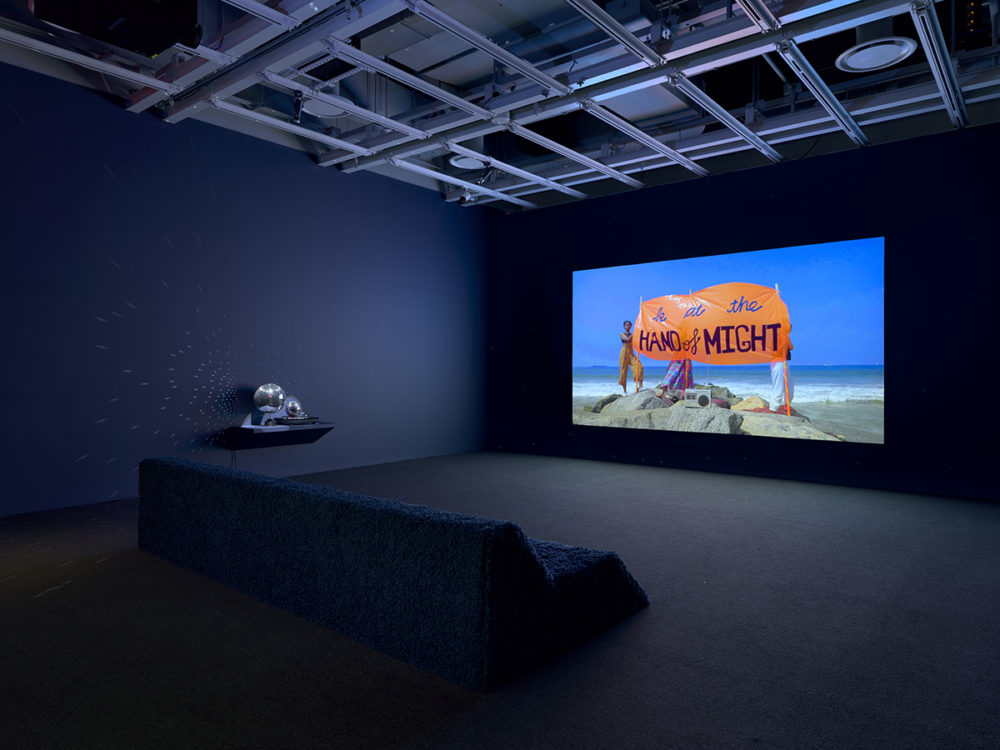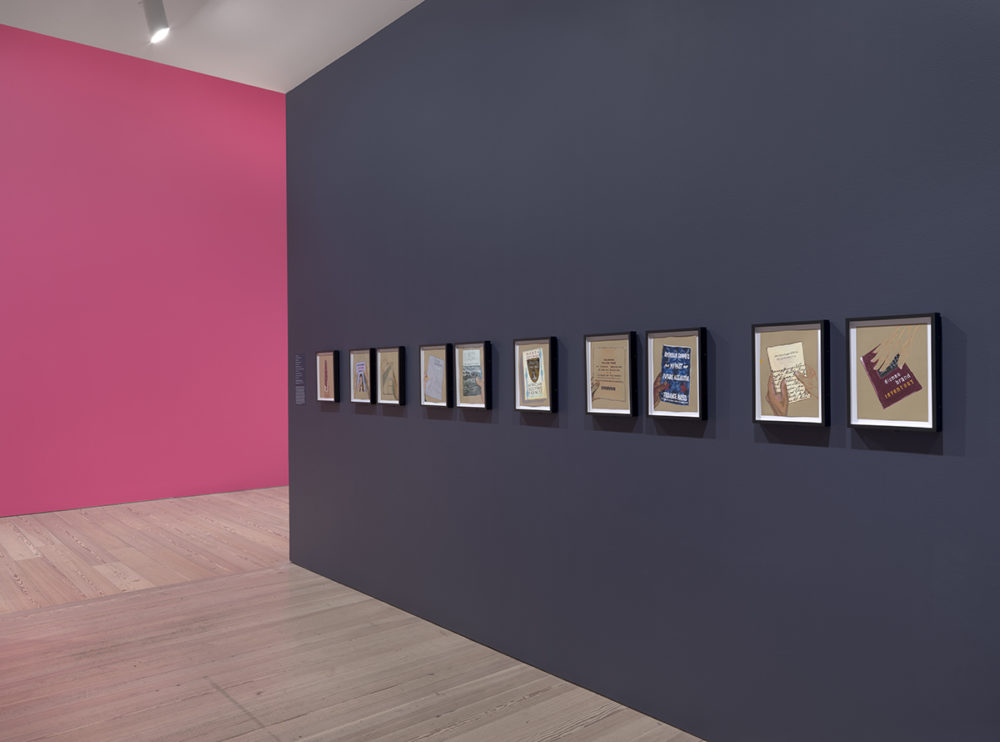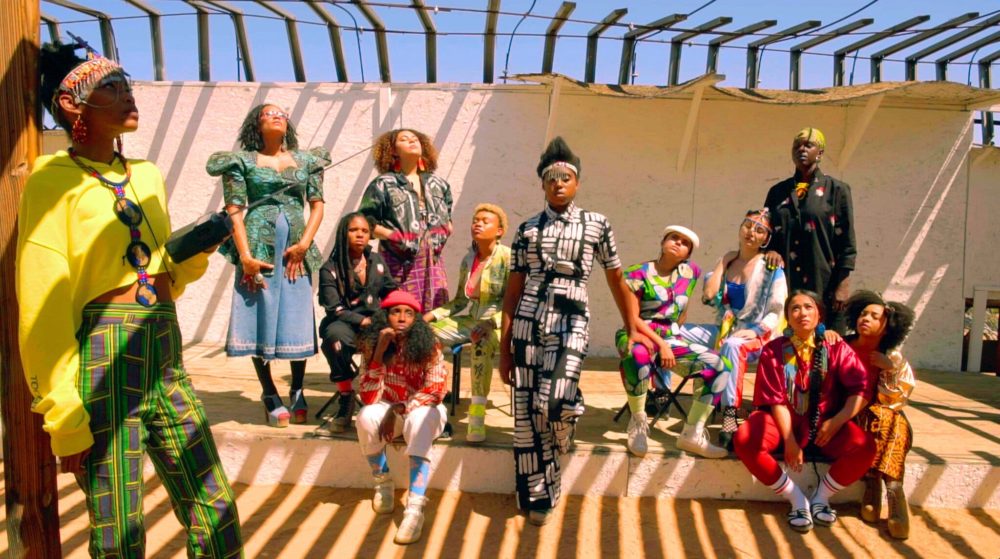
- Source: Art in America
- Author: Cauleen Smith
- Date: June 19, 2020
- Format: Digital
CAULEEN SMITH
ON HOW ART FACILITATES PROTEST AND INTROSPECTION
Cauleen Smith’s 1998 debut feature film Drylongso highlights societal threats toward Black men. Since its release, Smith has regularly explored topics such as African American identity and Black feminism in experimental films and multimedia art installations. Her recent film Sojourner (2018)—accompanied by a comfy couch and a disco ball—revisits Black spiritual and cultural history through the writings of Shaker visionary Rebecca Cox Jackson, abolitionist Sojourner Truth, and jazz composer and spiritual leader Alice Coltrane. Now, in the midst of protests against racial violence and discrimination, the artist imagines building a public reading room to house the books depicted in her drawing series “Human 3.0 Reading List” (2015-16) and “BLCK FMNNST Loaner Library 1989-2019.” Phrases from the suite of banners that Smith has shown at the 2017 Whitney Biennial and elsewhere were recently set to a gospel music score by composer Avery R. Young. Examples of her work will be on view in the exhibition “Mutualities” at the Whitney Museum of American Art, which is currently on hold as a result of the virus. Below, Smith reflects on the importance of cultivating inclusive public and private spaces that allow for personal reflection as well as generative conversation.

View of Cauleen Smith's film Sojourner, 2018, 22 minutes and 41 seconds; at the Whitney Museum of American Art.
I don’t understand artmaking without public space. When the Covid-19 shelter-in-place policy began and exhibitions were shut down, I was in crisis. Why bother making art if it’s only going to be experienced online? Yet people are out in the streets risking their lives to protest, and they need artwork that receives and shelters them. We can’t have a revolution without the grounding of art and culture. The Black Lives Matter protests really changed my idea of what public space can do and how we can invite institutions to change the way their spaces are used.
I worked with the Whitney staff to design a giant twelve-foot-long seat that’s covered in blue shag carpet and sits in front of my film Sojourner. We call that seat the Cookie Monster. Visitors can lean, lie, sit, and perch on its soft luxurious surface however they choose. I want people to use it as a spot to be in repose. The point of creating this safe space was for visitors to spend time with the film and really listen. I always think of Sojourner as being in conversation with many different objects, wallpapers, surfaces, textures, and banners. By the time viewers watch the film, they have already received so much informational groundwork from the environment that the film can focus on conveying a particular kind of imagery or feeling. When the title credits appear at the end of Sojourner, the room is completely dark, and that’s the moment when people can see the disco ball installation producing a cosmos on the ceiling. I always consider who the work is made for and what I want it to convey. It is so important that people are given an experience that cultivates their intellectual and physical well-being. That’s why I started making installations for my films, instead of simply showing them.

View of Cauleen Smith’s exhibition “Mutualities,” 2020, at the Whitney Museum of American Art. From left to right: Alexis Holds Audre Lorde, 2020; Natalie Diaz, 2020; Natalie Holds Dionne Brand, 2020; Gregg Bordowitz, 2020; Gregg Holds Robert, 2020; Latasha Gave Me African Sleeping Sickness, 2020; Krista Franklin, 2020; Krista Holds Terrance, 2020; Dionne Holds Sylvia D. Hamilton, 2020; and Dionne Brand, 2020. Photograph by Ron Amstutz.
I made the “Human 3.0 Reading List” and the “BLCK FMNNST Loaner Library 1989-2019″ out of a sense of urgency. I wanted these books to be noticed, and, in our photo-saturated world, drawing them slowed people down and invited renewed interest. One thing I can offer young people is information on how to use language to affect change. Police are not just killing Black men, they are killing Black people—men, women, and trans people.
Post-slavery, Black people had a very communal ethic tied to a refusal to be in alignment with the system that kept us captive, oppressed, and shackled. At the beginning of the twentieth century, the next wave of Black leaders, like Marcus Garvey, were committed to allying with material prosperity or patriarchal capitalistic modes of liberation. Black women are organizing us and articulating what we need—and that’s always been the case, even if it wasn’t acknowledged. We have to understand why now is the time for a feminist-led movement and why it’s never happened before.
I have lived in Los Angeles for about three and a half years, and I’m quite keen on the idea of contributing a reading room to the city filled with the books from the “Human 3.0 Reading List” and the “BLCK FMNNST Loaner Library 1989-2019,” so that people can stop on their way to or from a protest and collect their minds and bodies. I imagine this as a space where anybody is welcome, as long as they respect it and the people in it. Many people don’t have time to read right now, but I’m hoping they get to it.
My banners take up the form of protest, but they’re really an invitation for personal meditation and introspection. I deliberately make my work that way, so that it can’t easily be coopted by a political agenda. I appropriate forms from social institutions that organize masses, and then I undermine them. Groups of people can find common ground, and yet individuals can still maintain and question their own position—as opposed to me telling anyone what to think. Recently, Avery [Young] borrowed text from the banners to make a gospel song. It was profound!

A still from “Sojourner” (2018), by Cauleen Smith. Courtesy of Cauleen Smith, Corbett vs. Dempsey, Chicago, and Kate Werble Gallery, New York
I started a Covid Manifesto on Instagram to disrupt our dependency on social media and the ways in which it soothes us. Over the years I’ve made a lot work about the police and capitalism, but I want to be present for what’s happening right now. Our estranged relationship with this planet is the reason for Covid-19. Full stop. Our leaders are so obsessed with the maintenance of this exploitative economy that we can’t have a conversation about how to live. Art is for creating another space that isn’t about power, but rather about intimacy, fragility, and humanity.
Students were really traumatized by having their spaces taken away, and it made me think about what public means—even beyond this virus. If we want to progress as a society, we need to engage our surroundings. We have an opportunity to dissect our assumptions about the system in which we live—from the institutions to the workers. I hope we take that hard look. It was exciting when New Orleans took down their Confederate monuments and left empty plinths. I have no desire to see them filled. There’s so much possibility in the blank space.
I used to teach at the University of Texas in Austin. It’s one of the few campuses that has a statue of Martin Luther King. Every year on Martin Luther King Day, someone would deface the statue. Meanwhile, the Jefferson Davis statue on campus went untouched. Every time there was a defacement, the community had to address what happened: people would rally around the statue and talk about what it meant to them. The defacement was an interesting social harm that always produced a huge dividend of social good. The way in which any figure occupies space speaks to the fact that they’re not harmless at all.
—As told to Francesca Aton

